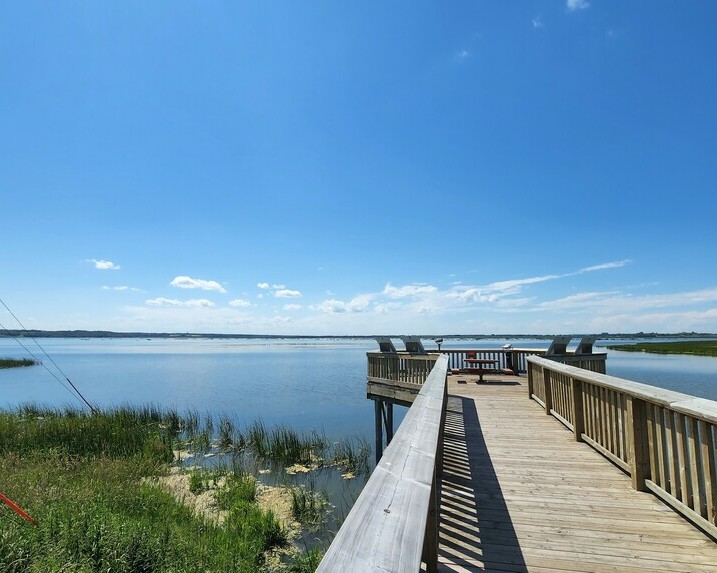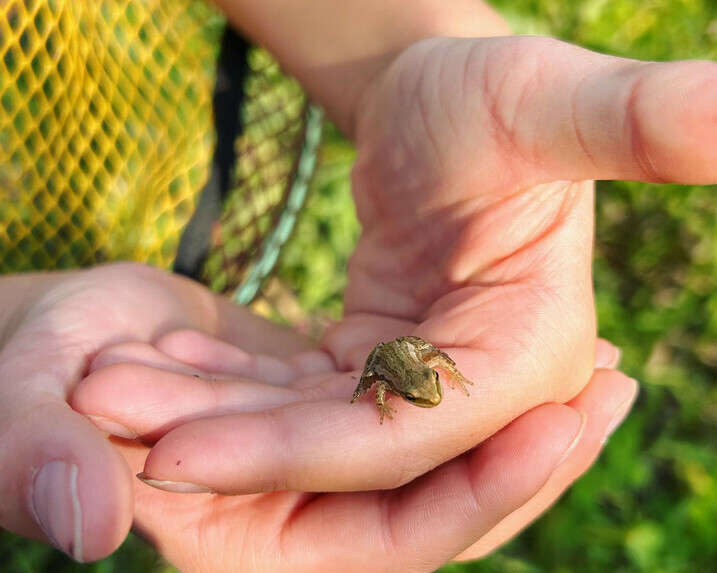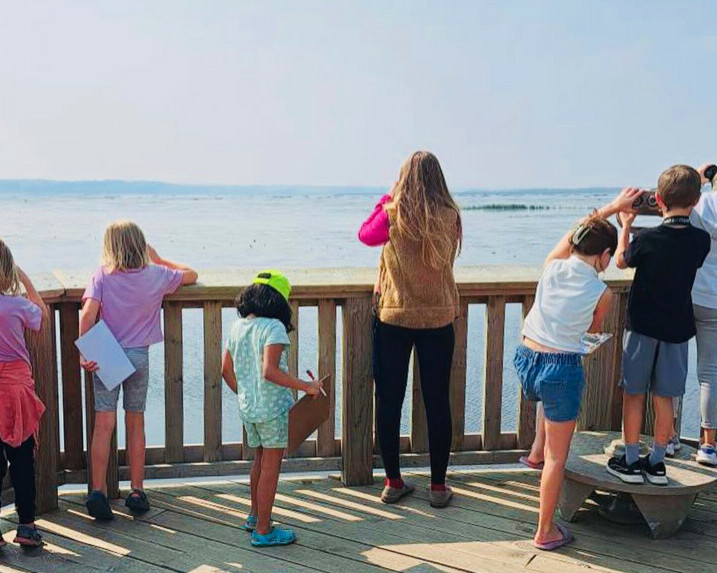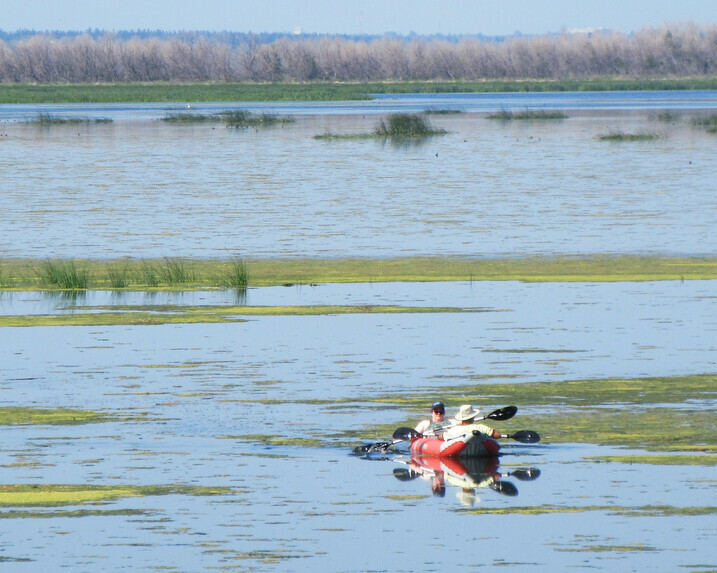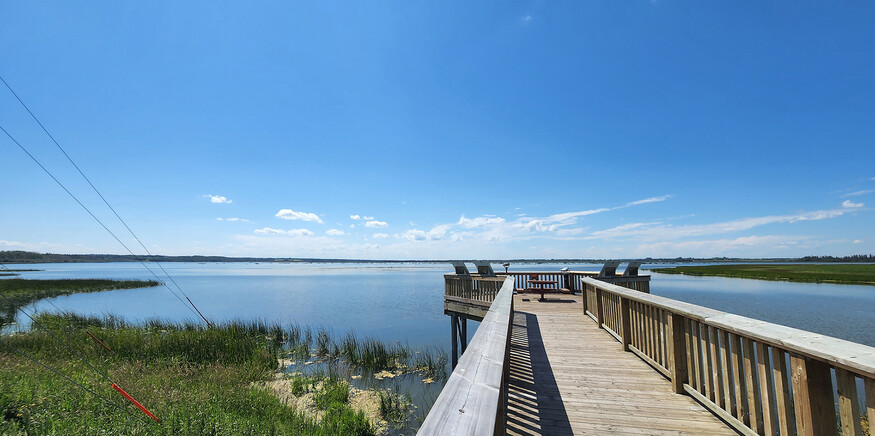
Stories of stewardship are stories of care and connection at their core. People are drawn to steward a waterbody or natural area because of some intrinsic value they’ve felt or experienced in these places, and lake stewardship is no different. NSWA wanted to delve a little deeper into one story of stewardship to highlight some of the challenges and opportunities faced by these organizations.
BLESS-ED BEGINNINGS
In the early 1990s, Dr. Fin Fairfield of St. Albert was troubled by his daughter’s comments about the poor state of the environment. Stirred to action, Fairfield went to see his friend – and avid naturalist – Dr. Bob Lane about the matter. Fairfield suggested they form a group to construct a shelter and platform at Big Lake under the name Big Lake Environment Support Society (BLESS). The name stuck and the group began holding Octoberfest dinners and applied for Lottery Funds to raise the $12,000 needed for the construction project.
After the platform was built, BLESS’s vision to protect and steward the lake kept expanding. With effective lobbying by BLESS, the lake and wetlands around the lake were designated as Big Lake Natural Area in 1999 and the area was chosen as an Alberta’s Special Places site the following year. With Bob Lane’s further lobbying it was also designated a globally recognized Important Bird Area (IBA), with several Species at Risk among the over 230 bird species recorded there. On Earth Day 2005, a broader area encompassing the lake became Lois Hole Centennial Provincial Park, over half of which is comprised of Big Lake.
Throughout its three decades, BLESS’ volunteers have brought a diverse range of expertise and passion to the lake stewardship group. Among these have been wildlife biologist Louise Horstman, long-serving BLESS executive member Dave Burkhart, and City Councillor Bob Russell who worked tirelessly to protect the Lake from an encroaching Ray Gibbon Drive. Founding member and President, Dan Stoker started the Summer Nature Program in 2003 and Al Henry has served as President for many years.
Having a range of talents and skills amongst stewardship members is helpful for navigating the various issues that arise. Some of the needed skills (that left unaddressed, can become challenges) mentioned in a Living Lakes report on water monitoring and stewardship are: Connections with similar groups, education and awareness, training for monitoring, financial reporting, and grant application funding for projects. The current longest-serving members of BLESS are Miles Constable (who joined in the 1990s) and Pat Collins. They were recently awarded the Queen’s Jubilee Medal for their volunteering endeavours and have both worn many hats as board executives. As current Treasurer, one of Constable’s most appreciated skills is his ability to successfully apply for grant funding to keep BLESS afloat.
A UNIQUE ROLE AS STEWARDS
Lyn and Tony Druett both serve as directors of BLESS, and Tony is their expert on municipal planning. They were first invited to a meeting of the BLESS board by President Al Henry, and attended what they thought would be a meeting for the general public. They recall with a laugh how by the end of the meeting, they’d become BLESS’s newest board members.
BLESS currently has approximately 40 members, of which 12 are now active members of the board of directors. Although most of the members do not live right at the lake, they all appreciate its unique beauty and make it a priority to spend time at the lake. While there, they often engage visitors in friendly conversation and tell them about what they do and what they’ve been up to. Their informal yet enthusiastic presence represents the best of what lake stewards do.
With no Provincial Parks staff office on site, the Druetts explain how BLESS members have a rather unique role in the park. Their stated objective is “We are the designated stewards of Big Lake and the Big Lake area.” This role includes ongoing contact with the Parks staff and filing stewardship reports with the province on activities around the lake. The Parks staff are particularly notified “if there are things going on that aren’t right” and BLESS’ responsibility is typified by an incident that occurred a couple of years ago. “The area was being illegally farmed for hay. A watchful member pointed that out to the executive and we informed the Parks [staff]. Alberta Parks took them to court and there was a settlement. Since then, there hasn’t been any illegal haying in the park.” Tony explains, “It would still be going on if we hadn’t stepped in.”
BLESS also has a history of stepping in and speaking out on matters pertaining to development surrounding the lake. Tony Druett’s background as a land development engineer and land planner in Edmonton and St. Albert has benefitted BLESS as they speak out about a new proposed development around the lake. The group is currently lobbying the City of St. Albert to ensure areas southeast of the lake remain as protected park areas.
NSWA Watershed Planning Coordinator, Kelsie Norton, works closely with lake stewardship groups and notes that each group has a unique approach and way of operating. “Lake groups face similar issues with water quality, water quantity, and so on, but in terms of how they go about their efforts or initiatives, they are quite different.” She cites the example of the Pigeon Lake Watershed Alliance (PLWA) in the Battle River watershed getting involved in protecting the lake from a proposed intensive feed lot while other groups such as Lake Isle Lac Ste Anne Water Quality Management Society (LILSA) that are “very nonintrusive” on land development issues.
“If we hope to preserve our way of life, the first thing we must do is rediscover our respect for the land, the water, and the entire natural world. And if we do manage to regain that respect, then we must make sure that human beings never lose it again.”~ Lois E. Hole
SUPPORTING LAKE STEWARDSHIP: ALMS
As the Executive Director of the Alberta Lake Management Society (ALMS), Bradley Peter has regular contact with lake stewardship groups. Peter calls these groups “the most effective advocates and voices for lakes”, in terms of lake management relating to the Water for Life strategy while noting that they often have the least structure and support. Peter explains further, saying, “The renewed Water for Life strategy sets as a specific outcome the continued work by watershed stewardship groups to take community level action to safeguard Alberta’s water resources.”
At a recent ALMS gathering, Peter spoke about the dissolution of several of these groups, for three different reasons. One was because there was no primary successor, one lacked administrative capacity and the other lacked engagement. This raised questions around how WPACs and other funded groups like ALMS can support the sustainability of stewardship groups, “both financially and as volunteer-driven organizations”.
ALMS surveyed lake stewardship groups about how connected they were to other similar groups, how Covid had impacted their ability to engage members, and whether they’d considered dissolving in the past few years. The survey revealed that many stewardship groups were struggling with capacity and engagement. ALMS responded by creating a program called the Lake Stewardship Community of Practice, for which the NSWA provides “in-kind support for meetings and facilitating discussions”. Last year, they held four informal gatherings for lake stewards to present and share ideas with one another. Peter says feedback showed that it fostered community and ideas about how to engage lake residents and members across the province. For more information about joining meetings or for prior meeting presentations, see https://alms.ca/lake-stewardship-community-of-practice/.
PARTNERING WITH THE NSWA
The NSWA has a long history of supporting lake stewardship groups in the watershed by connecting their passion for protecting the lake to the science that supports good management decisions. NSWA has worked with several lake stewardship groups to complete state of the watershed assessments (LILSA, Mayatan, Hubbles, Antler) to summarize baseline data for the lake, and then develop lake watershed management plans (Mayatan, Wabamun). These documents can be used by the stewardship groups when working with their municipalities to help make better development decisions that consider the impacts to lake health.
The NSWA recognizes that many stewardship groups face similar problems – water quality, lake levels, and shoreline degradation – but have limited capacity to work at a lake by lake scale. With new funding, Norton has recently helped resurrect a Lakes of Parkland group, a regional collaboration of lake stewardship groups within the region that started in 2014. The group of lake association members and individual lake stewards discuss issues, share capacity, and develop solutions together, according to Norton.
FINAL THOUGHTS ON STEWARDSHIP
Kelsie Norton muses about lake stewardship, saying, “I think lake stewardship comes down to a mentality and just learning about your everyday actions and where you situate yourself.” She repeats a quote she heard recently that resonated with her. “We’re not communities on a lake we’re a lake community.” This holistic approach that views water, ecosystem, and people as interconnected is a critical piece of what stewardship groups are trying to model and work toward.
It seems fitting to conclude by quoting the eponym of the park surrounding Big Lake, former Lieutenant Governor and avid gardener, Lois Hole. Her comments about the natural world speak to the importance of stewardship. “If we hope to preserve our way of life, the first thing we must do is rediscover our respect for the land, the water, and the entire natural world. And if we do manage to regain that respect, then we must make sure that human beings never lose it again.”
~ Lois E. Hole
Learn more or join a Lake Stewardship Group:
- Join the Alberta Lake Stewardship Community of Practice Group
- Watch NSWA’s Kelsie Norton present on “Lake Stewardship & Restoration Opportunities”
- Find out more about Big Lake Environment Support Society (BLESS)
